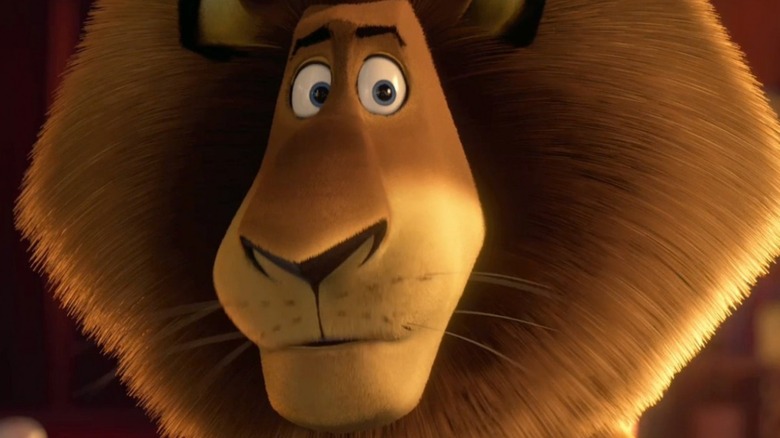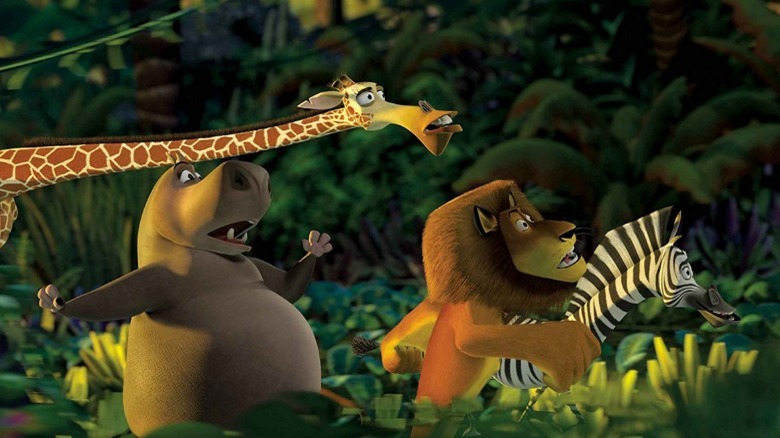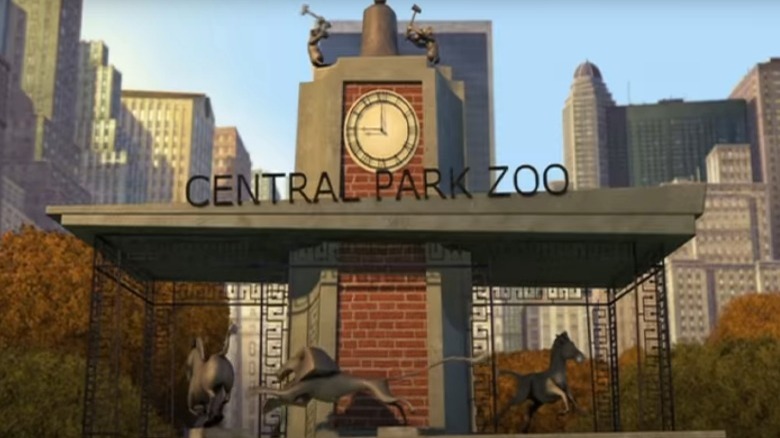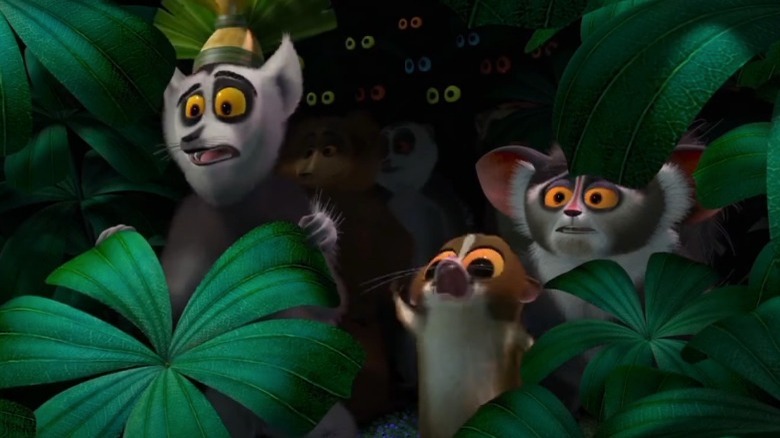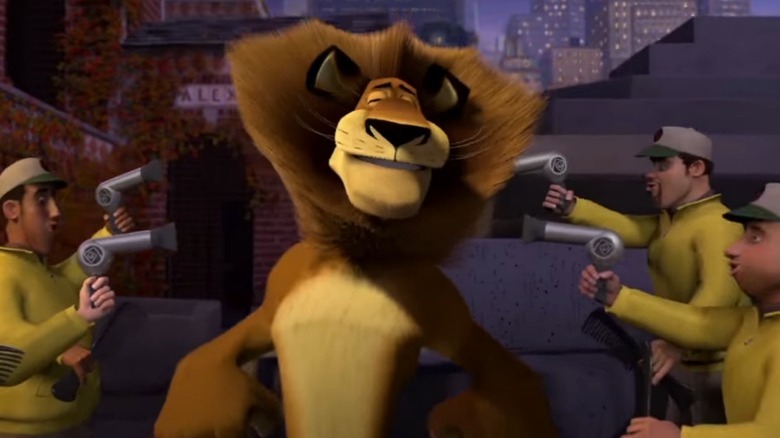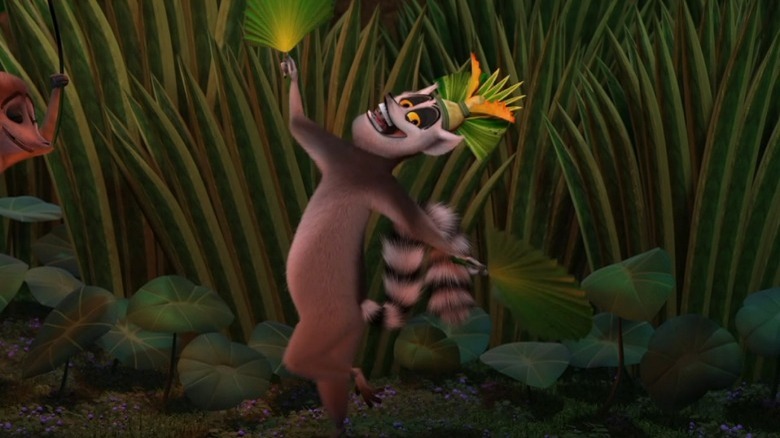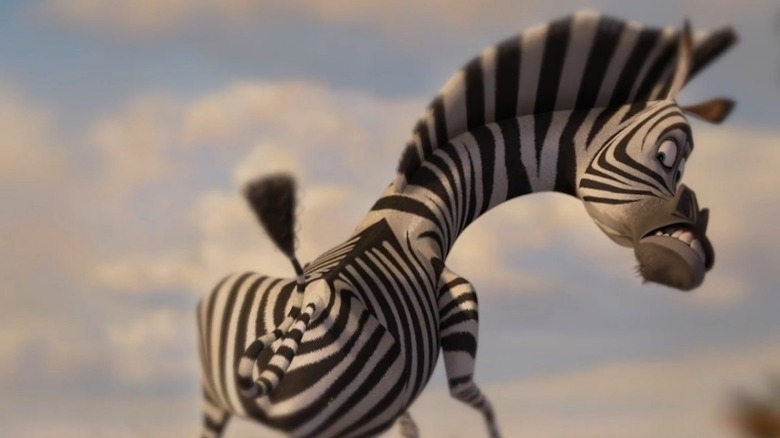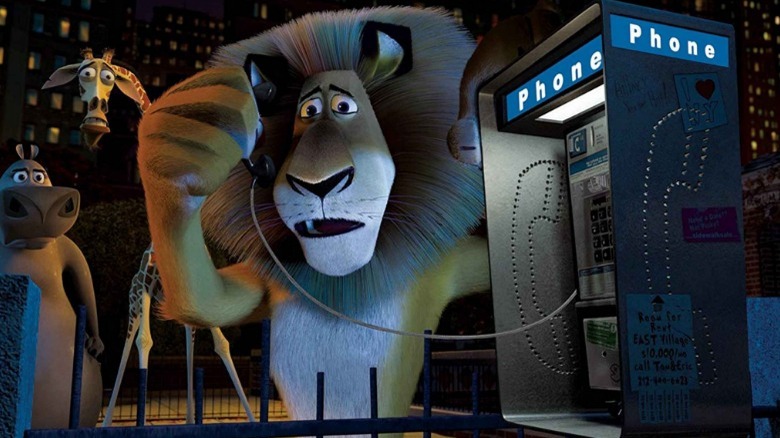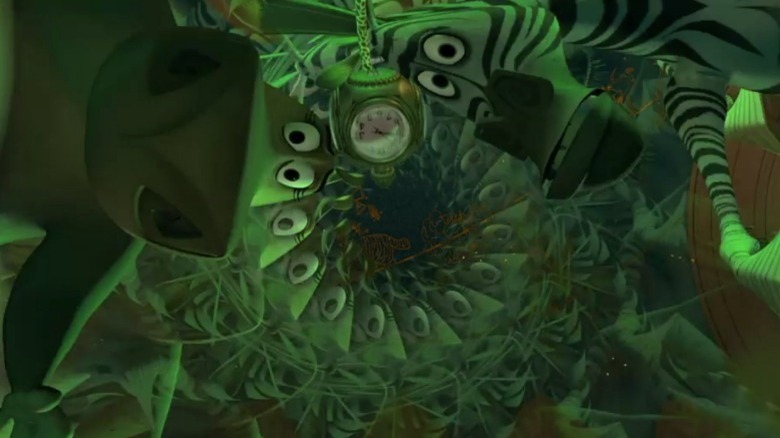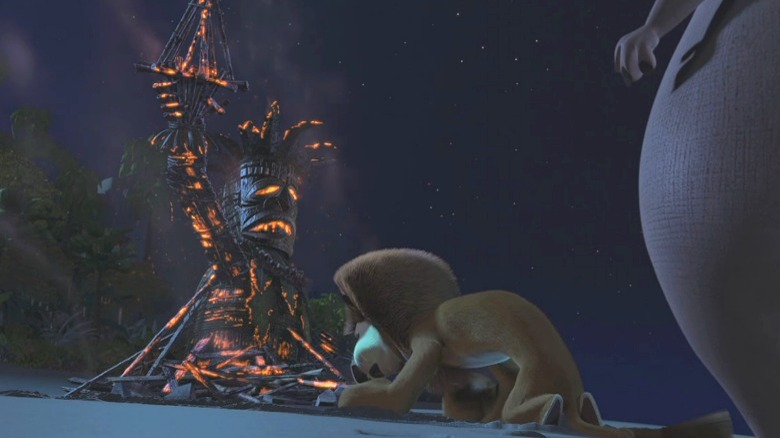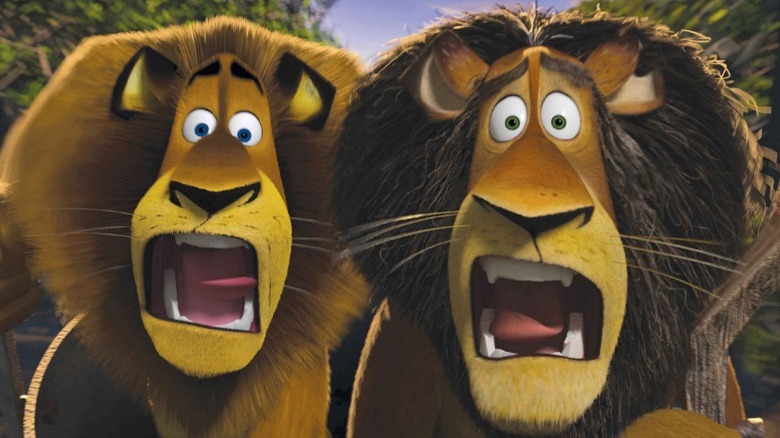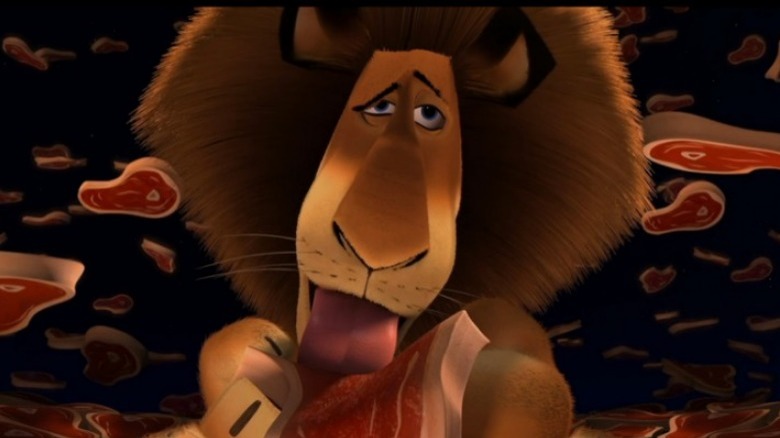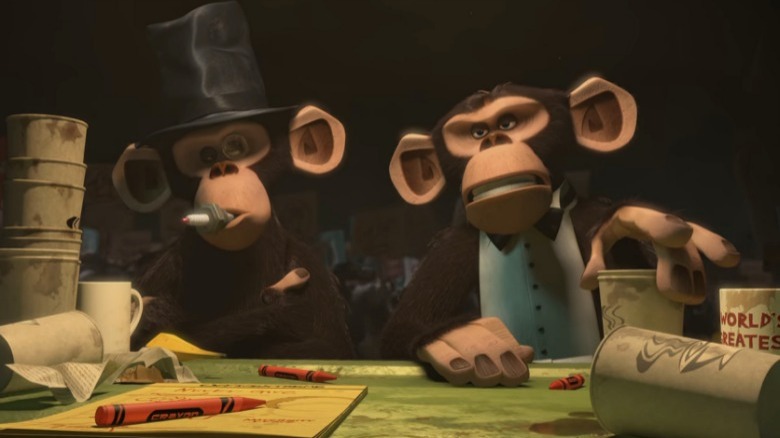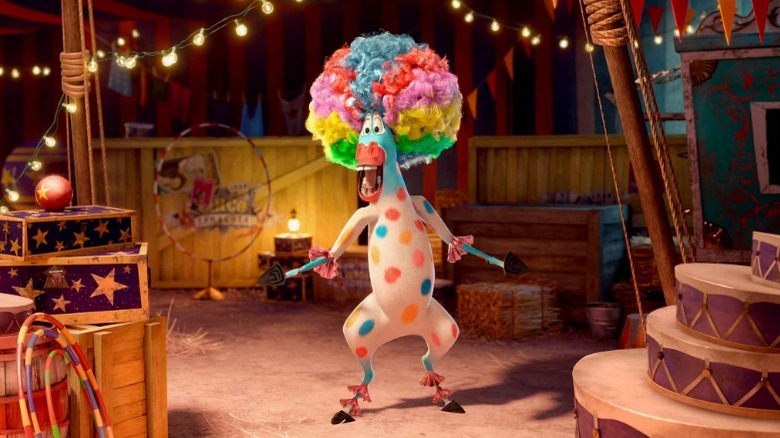Things Only Adults Notice In The Madagascar Film Franchise
DreamWorks Animation's "Madagascar" franchise is one of the most beloved kids' movie series in recent memory. The first film won so many fans when it premiered in 2005 that it led to two sequels, 2008's "Madagascar: Escape 2 Africa" and 2012's "Madagascar 3: Europe's Most Wanted," as well as a spinoff, "Penguins of Madagascar" in 2014. With colorful animal characters brought to life with funny and endearing voice performances by big names like Ben Stiller, Chris Rock, Jada Pinkett Smith, and David Schwimmer, it's no surprise that "Madagascar" was a hit with kids and adults alike.
Yet, even if they both have a blast watching the "Madagascar" films, kids and adults won't exactly have the same experience. That's because there are plenty of plot points, jokes, and references that will go right over children's heads, but will cause adults to laugh, nod in recognition, or maybe even cringe in disapproval. Here are some examples of the things only adults will notice in the "Madagascar" franchise.
Lions, zebras, giraffes, and hippos aren't friends in real life
If children's pop culture is to be believed, all animals are friends — including all the animals in "Madagascar." The film's core cast includes a lion, a zebra, a giraffe, and a hippo who happen to live at the same zoo and have formed lifelong friendships as a result. This is something adults are well aware is simply ridiculous, a product of kids' entertainment we all just go with despite its inaccuracy.
The reality is Alex the lion would be more likely to eat Marty the zebra than befriend him. This is a fact the first movie in the series plays with when the animals get stranded on the titular island nation and Marty starts to looks increasingly delicious to a very hungry Alex. Friendship and civility win out in the end in "Madagascar," but real wild animals aren't concerned with such things, which means in real life, the moment Alex got hungry, Marty would be a goner.
The Central Park Zoo is a real place (but it doesn't have the same animals)
Outside of New York City kids, most won't know that Central Park is a real place in the middle of Manhattan, much less that it does include a small zoo. However, the real Central Park Zoo doesn't feature any of the large animals that star in "Madagascar." This is a zoo in the middle of a bustling city, after all, and there just isn't enough land available to safely house lions, giraffes, hippos, and zebras. Plus, these animals are social and don't live alone in the wild, so including only one member of each species in a zoo — as the fictional Central Park Zoo in "Madagascar" does — would just be cruel.
The biggest animals currently housed in the Central Park Zoo are grizzly bears and snow leopards. Interestingly, the zoo currently includes an exhibit featuring several species of penguins, although none of them are Adélie penguins, the species of the secret agent-minded quartet of penguins in the "Madagascar" franchise.
The movie depicts wildlife unique to the island of Madagascar
When Alex the lion, Marty the zebra, Melman the giraffe, and Gloria the hippo find themselves on Madagascar, they encounter predators called fossa and a large kingdom of lemurs that's led by the ridiculous King Julien. The movie doesn't put a fine point on it, but many adults will realize these are mammals native to Madagascar that don't live anywhere else in the world. King Julien and his followers are terrified of the fossa, a fear inspired by the real-life predator-prey relationship between these animals. That's right — in the wild, lemurs make up a majority of the fossas' diet. The film's also accurate in portraying the many, many species of lemur. King Julien is a ring-tailed lemur, which is perhaps the most well-known of the over 100 species of these primates that live on Madagascar. That's a lot of lemurs!
On the other hand, there's quite a bit the movie overlooks, including the fact that over one-third of lemurs are critically endangered. While "Madagascar" the movie makes the island nation look like a wilderness paradise where lemurs' only issue is the deadly fossa, in reality millions of people live there, leading to issues like hunting and deforestation, which are more lethal to lemurs than the fossa could ever be. Still, the movie is a great way for adults to introduce kids to these unusual animals and start a conversation about them.
Alex the lion is a parody of spoiled celebrities
From the beginning of "Madagascar" it's clear that Alex is the star of the Central Park Zoo — and that he's become accustomed to living the celebrity lifestyle. All that public adoration has made him a bit narcissistic. Not only does he cluelessly gift Marty an Alex-branded snow globe for his birthday, he's an incredible showboat who lives for the attention of the crowd, and the crowd loves him for it.
To drive the point home, as zoo security disperses his fans at the end of the day, Alex encourages them to "Check out my website — 24-hour Alex-cam! Watch me sleep!" This indicates that, like a lot of zoos, fictional Central Park Zoo of "Madagascar" has a website that includes live-camera feeds from specific exhibits. However, like a lot of celebrities who share way too much of their lives, Alex thinks of the live-feed as a way to stay connected with his fans even when he can't be with him. It's a knowing parody of our culture's obsession with celebrity that will make adults chuckle but won't resonate the same way for the kids.
Sacha Baron Cohen's Indian-accented voice work as King Julien is seriously problematic
Kids adore the madcap King Julien, but Sacha Baron Cohen's choice to give the goofy lemur an Indian accent would be considered deeply inappropriate today. While no one seemed to pay too much attention to Baron Cohen's accented voice work when the first movie hit theaters in 2005, recently there's been a movement in pop culture to ensure non-white characters are played by actors of color. One prominent example is Hank Azaria stepping down from voicing the role of Apu on "The Simpsons." Given Baron Cohen is white, his decision to use an Indian accent as a vehicle to make King Julien funnier comes across as racially insensitive.
Of course, it also makes no sense given that Madagascar is an island off the coast of Africa, so there is absolutely no reason for King Julien to have an Indian accent. By "Madagascar" co-director Tom McGrath's own admission, the filmmakers found Baron Cohen's Indian-accented take on the character hilarious and actually increased the size of the role because of it. Looking back, though, adults will see that choice as questionable, if not downright inappropriate, even as the kids continue to laugh at the character's zany antics.
So much cursing
For a series of kids movies, the "Madagascar" franchise includes a decent amount of veiled cursing that most kids are likely to miss but will certainly catch the attention of adults. One of the boldest examples happens when Alex and the gang land on Madagascar and a furious Alex chases Marty, who he blames for their predicament. As Marty sprints away from Alex, he yells, "Sugar, honey, iced tea!" It's a seemingly random series of words whose first letters spell out a certain four-letter expletive.
Then there's the far less subtle exclamation of "Hoover Dam!" by Skipper, the leader of the penguins, when he learns that instead of tunneling to Antarctica, he and his cronies have only made it to Marty's zebra enclosure. While parents may initially appreciate the clever wordplay, they may not be so charmed if their children start using the utterance to get around rules about cursing, just like the movie does.
Alex and the other animals are send-ups of die-hard New Yorkers
The animals from the Central Park Zoo exemplify stereotypes about native New Yorkers. This is especially the case for Alex, who thinks New York City is the greatest place in the world. He even prefers the city sounds of traffic and sirens to the "wild" ambient noise piped in by the zoo. And no one is more devastated to be shipped away from the City than Alex, especially when the animals land on Madagascar and mistake it for San Diego. Like many a native New Yorker, Alex despises California, so in his mind, no place could be worse than San Diego, which he mocks for what he assumes will be its hippie culture.
Meanwhile, when he divides the beach of Madagascar between himself and Marty, Alex declares Marty's half the "Jersey side," yet another acknowledgement of New Yorkers' opinions about places other than their hometown. By the time "Madagascar 3" rolls around and Alex and his friends still haven't made it back to New York, Alex is achingly home sick. To ease his pain, Marty, Gloria, and Melman make him a miniature replica of the city, which only makes Alex more determined to return. And while kids in the audience will identify with Alex's attachment to his home, adults will recognize the way the animals' attitudes send up city dwellers, including Alex's declaration that he doesn't drive because he's "a New Yorker."
The animals get high as a kite whenever they're shot with tranquilizers
Several guns appear in the "Madagascar" franchise, but the good news is that most of them don't contain actual bullets. Instead, they're loaded with tranquilizer darts, which means the animals are never in danger of getting seriously hurt. However, instead of simply sedating them, as viewers might expect, the tranquilizers have what adults will know is an intoxicating effect on the animals.
In the first film, Alex the lion has a psychedelic drug trip set to the tune of "The Candy Man" by Sammy Davis, Jr. after Animal Control shoots him with a tranquilizer in Grand Central Station, where he and his friends have gone to find Marty. Then, in the third film, fanatical Animal Control Captain DuBois shoots King Julien with a tranquilizer dart, causing him to pass out briefly. After he wakes up, however, he seems to have fun in his altered state, although kids probably won't connect the dots regarding his wackier-than-usual reactions and the parallels to a human on a drug high.
There are tons of movie references
From "Cast Away" to "American Beauty" to "Saturday Night Fever," the "Madagascar" series contains a ton of movie references that adults will enjoy. But since almost all of them are nods to older movies and movies that aren't for kids, they will likely go right over children's heads.
Nonetheless, some of these bits are still funny whether you notice the movie reference or not. For example, the first film includes a reference to "Planet of the Apes." As Alex's replica of the Statue of Liberty burns to the ground, leaving only part of its upper body poking out of the sand, Alex yells, "You maniac!" in response. While the reference to Charlton Heston's devastating discovery at the end of the 1968 movie makes for a funny moment, kids who've never even heard of "Planet of the Apes" are likely to laugh right along at Alex's exaggerated response.
Similarly, early in the second movie, when Alex looks out the window of the animals' plane, he sees Mort on the wing and initially mistakes the small lemur for a gremlin. While adults of a certain age will have no trouble recognizing this as a reference to "The Twilight Zone," the scene is still comical enough to elicit a few chuckles whether viewers understand the nod to the classic series or not.
Alex's father wouldn't welcome him back to the pride as an adult
In the second movie in the series, "Madagascar: Escape 2 Africa," Alex, Morty, and the gang crash land in Africa and Alex reunites with his long-lost parents, including his father Zuba, who was devastated after he lost his son when he was just a cub. Zuba welcomes Alex back into the pride with open arms, but adults who've studied up on lions will know that this would never happen in reality. That's because life for real lions isn't easy, and that can be especially true when it comes to relationships between adults and younger males.
When young male lions are on the cusp of maturity, the adult males kick them out of the pride in order to maintain their position of dominance, something that Zuba would have done to Alex had Alex stayed in Africa. The movie understandably ignores this reality, and instead anthropomorphizes Alex's biological lion family. While this is definitely more comforting for both adults and kids, adults will know the reality is much bleaker.
Alex thinks steak is ... sexy?
There are some pretty weird moments of sexualization that only grown-ups will notice in the "Madagascar" films, one of which revolves around Alex's devotion to his favorite food: steak. In fact, early in the first film, Alex has a dream about filet — and based on the sweet nothings he mutters in his sleep, his dream is pretty much a sex fantasy. Alex is seen licking and cuddling steak on other occasions too, solidifying his odd fetish for meat.
The franchise also has a strange habit of sexualizing hippo Gloria, the lone female star of the movies. In the first film, she emerges onto the island of Madagascar wearing two strategically placed starfish and a crab to simulate a bikini. Then, in the second film, Gloria enjoys a flirtation with the hulking hippo Moto Moto, but it quickly becomes clear that Moto Moto's only interested in Gloria's body. While Moto Moto is attracted to Gloria's girth, flipping the traditional expectation that men covet women with petite bodies on its head, the movie isn't so much commenting on the objectification of women as playing it for laughs. This may make some adults uncomfortable given changing cultural norms.
The chimps go union
In the second "Madagascar" film, the penguins employ a large band of chimps to repair their plane because they're the only animals around with opposable thumbs. While this reasoning alone may escape children's notice, things may become even more obscure for them when the chimps decide to unionize and strike as a way to get better compensation from the penguins. It's an absurd scenario only adults will understand, and it becomes even more absurd when the all-male chimps' major sticking point is revealed: the promise of maternity pay.
The chimps' concern with their working conditions is once again brought up in "Madagascar 3." When the animals' plane crash lands in France, the penguins promise the chimps will fix it immediately without breaks or safety measures. But instead of adhering to their contract with the penguins, the chimps run off because, as lead chimp Mason explains, France's labor laws mean they only have to work two weeks a year — and apparently the chimps have decided those two weeks aren't happening until a later date.
Circuses are terrible for animals
One of the main settings of "Madagascar 3" is a circus where the animals all relish the opportunity to perform for people's amusement. For decades (right up through the 2012 release of "Madagascar 3"), circuses were considered a perfectly acceptable form of family entertainment. In reality, though, circuses are terrible for animals, and as awareness has spread since the release of the "Madagascar" threequel, circuses have faced a reckoning about their animal acts.
The issue comes down to the fact that unlike the animals in "Madagascar 3," wild animals who perform in circuses are forced to do so, often with cruel training techniques that include the use of bullhooks, sticks, and whips. If that weren't enough, the nature of these traveling shows means the animals can't follow any of their natural instincts to exercise or interact with other members of their species. The public outcry about this issue has led to the closure of Ringling Bros. and Barnum & Bailey Circus, as well as bans on wild animals in traveling shows in several countries and American states. So while kids may believe animals enjoy performing in circuses after watching "Madagascar 3," adults will know that in real life, circuses aren't the fun places for animals the movie makes them appear to be. And although this positive portrayal of a fictional circus may make some adults uncomfortable, it's also a good opportunity for parents to educate their children about the cruel realities faced by circus animals.
